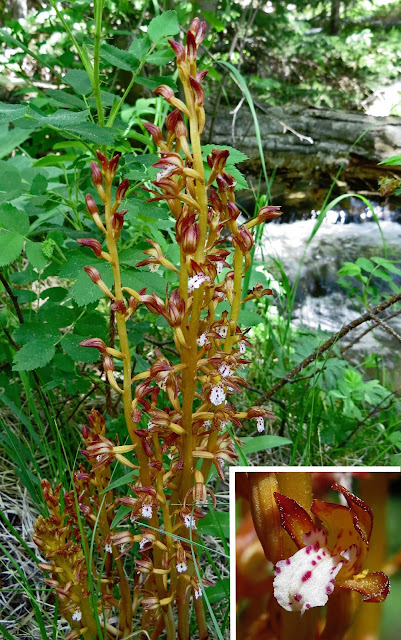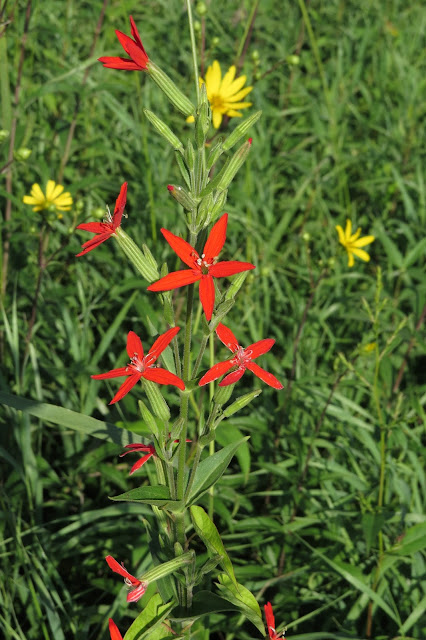One relatively level trail around a lake had the most incredible mid-summer flower meadows I've ever seen. Approaching the lake the hiker sees a few bits of color:
but up close the variety is just amazing:
Three of the most prominent flowers in this meadow are paintbrush (Castilleja sp), elephant heads (Pedicularis groenlandica), and American bistort (Polygonum bistortoides):
Along the streams grow beautiful Parry primroses (Primula parri):
A trail to a waterfall in the eastern part of the national park is different but equally rewarding.
Western wallflower (Erysimum capitatum) is a lovely member of the mustard family; it does grow in Ohio but in a very tiny population near the Ohio River. It is much more common in the west:
In the wet areas along this trail we found shooting stars (Dodecatheon pulchellum). We have similar shooting stars in Ohio forests but they are white instead of pink:
We love to discover orchids when we are hiking, and this spotted coralroot (Corallorhiza maculata) was well worth many photos! The inset photo is a closeup of a single tiny flower.
This plant has no chlorophyll and is completely dependent on a complex relationship with fungi and even trees for its energy. All orchids depend to some extent on fungi but the coralroots take this to the extreme. In Ohio we have its relative, crested coralroot.
A summer visit to Colorado wouldn't be complete without seeing the state flower, Colorado blue columbine (Aquilegia coerulea). The darker yellow flower in the photo below is called golden banner (Thermopsis montana), which can occur in large colonies, and the lighter yellow one is a type of paintbrush (Castilleja sp). There are many colors of paintbrush including deep red ones and magenta ones; they hybridize and are often difficult to identify as to species.
Here is an unusual plant you won't find in Ohio--miner's candle (Cryptantha virgata). It is a member of the borage family. Its nut-like seeds provide food for songbirds throughout the winter.
A common plant in shady areas of montane woodlands is heartleaf arnica (Arnica cordifolia). It spreads underground via rhizomes, which can result in large patches of these cheery flowers:
Another wonderful hike led us into the montane habitat along a rushing stream to a roaring cascade. This shady walk featured some really beautiful and unusual flowers. This one is called rock clematis (Clematis columbiana), a vining relative of the big clematis plants that we see in Ohio gardens, often climbing up lampposts!
Here is a stunning flower, the Calypso orchid or fairy slipper (Calypso bulbosa). It is not common at all, but has a circumpolar distribution, occurring in northern areas around the globe.
Isn't that amazing? Here is a closeup of the flower:
On the last day of this year's visit to Colorado we hiked to a small lake that was partially surrounded by forest. Before entering a lovely aspen grove, the trail followed a stream up through a meadow:
A few beautiful wood lilies (Lilium philadelphicum) grew in the meadow beside the trail:
Fires are not unusual in this area, and one plant that often colonizes burned areas is aptly called fireweed (Chamerion angustifolium):
It grows to about three feet tall and often forms large colonies.
Parry Bellflower (Campanula parryi) is a delicate plant that just has a single flower and is relatively uncommon. This species and the Parry primrose above are named for Charles Parry, a nineteenth century explorer of the west. He has been called "the king of Colorado botany"--must have been an interesting fellow!
Here is a dragonfly that was completely unfamiliar to us, called a belted whiteface, which only occurs in the west:
This yellow-bellied marmot was keeping a lookout in a meadow area on a lichen-covered rock:
So that is a very brief overview of some mid-elevation habitats in the southern Rockies. Trails that we have done in this area have all been easy to moderate in difficulty and well worth the effort!




















































